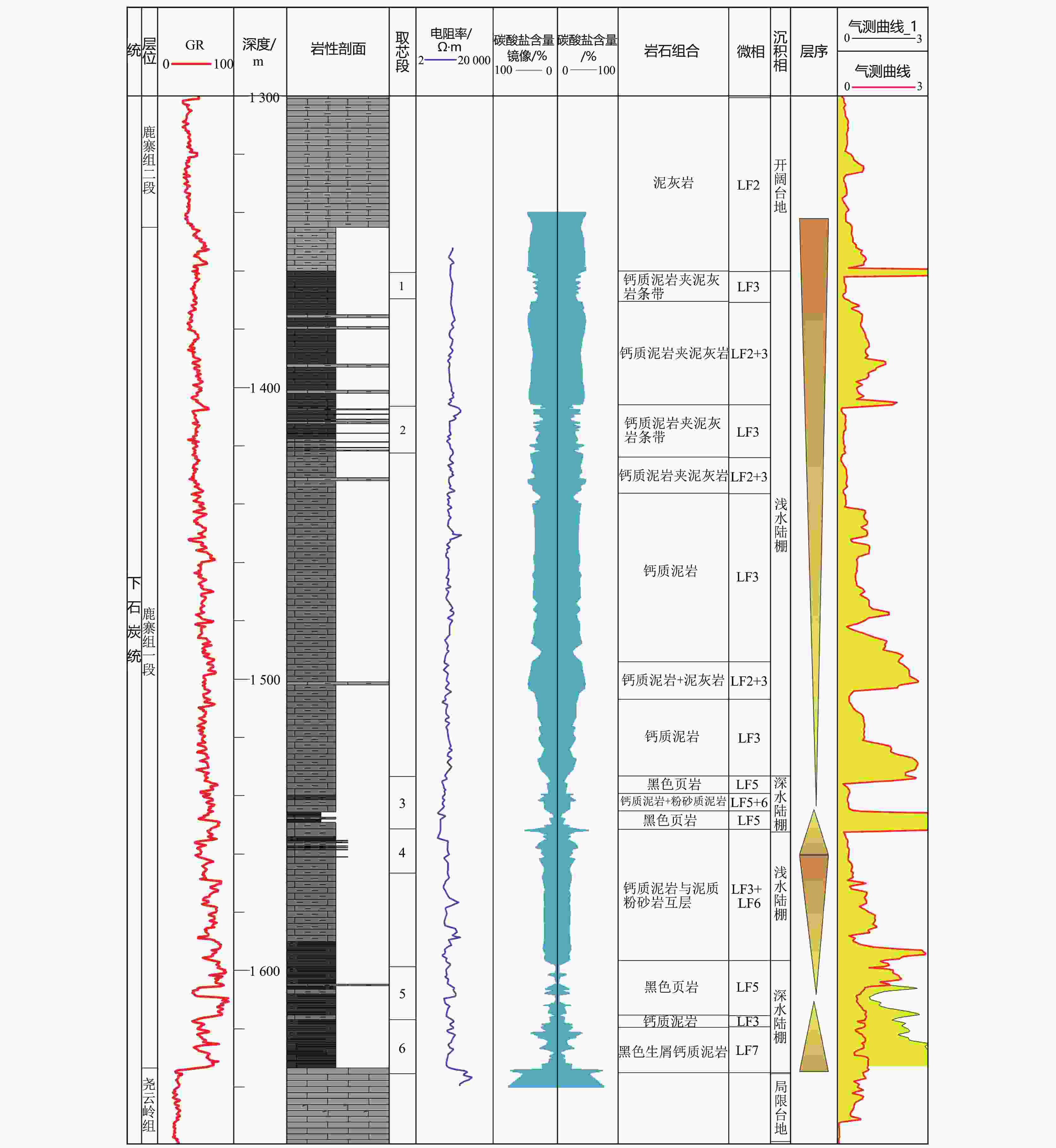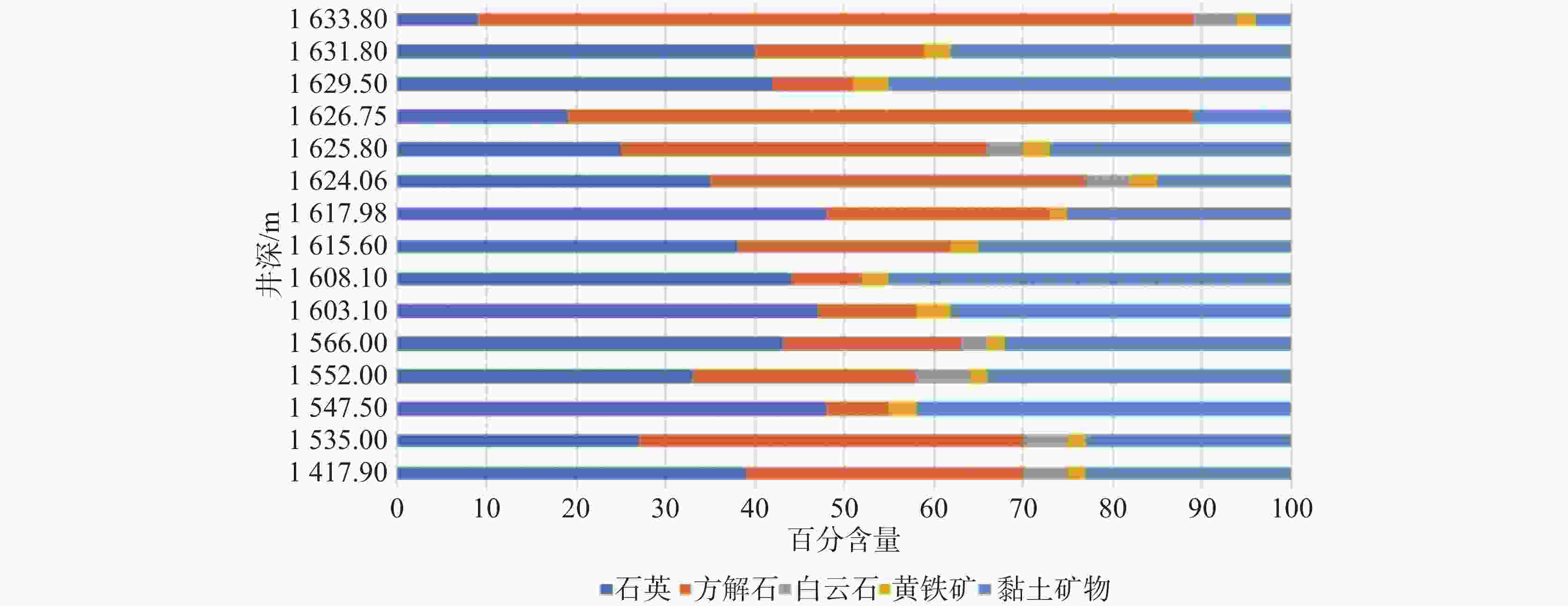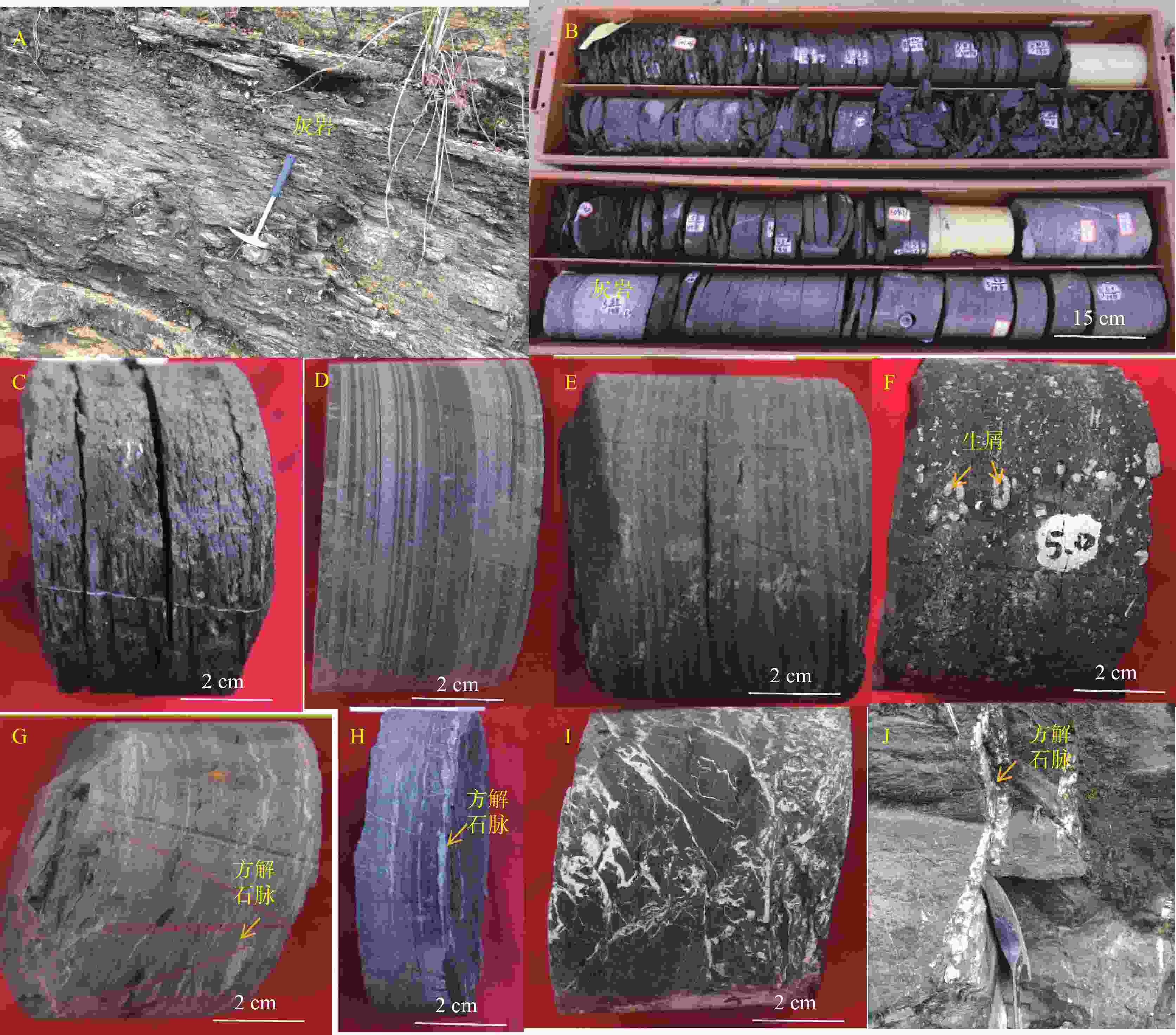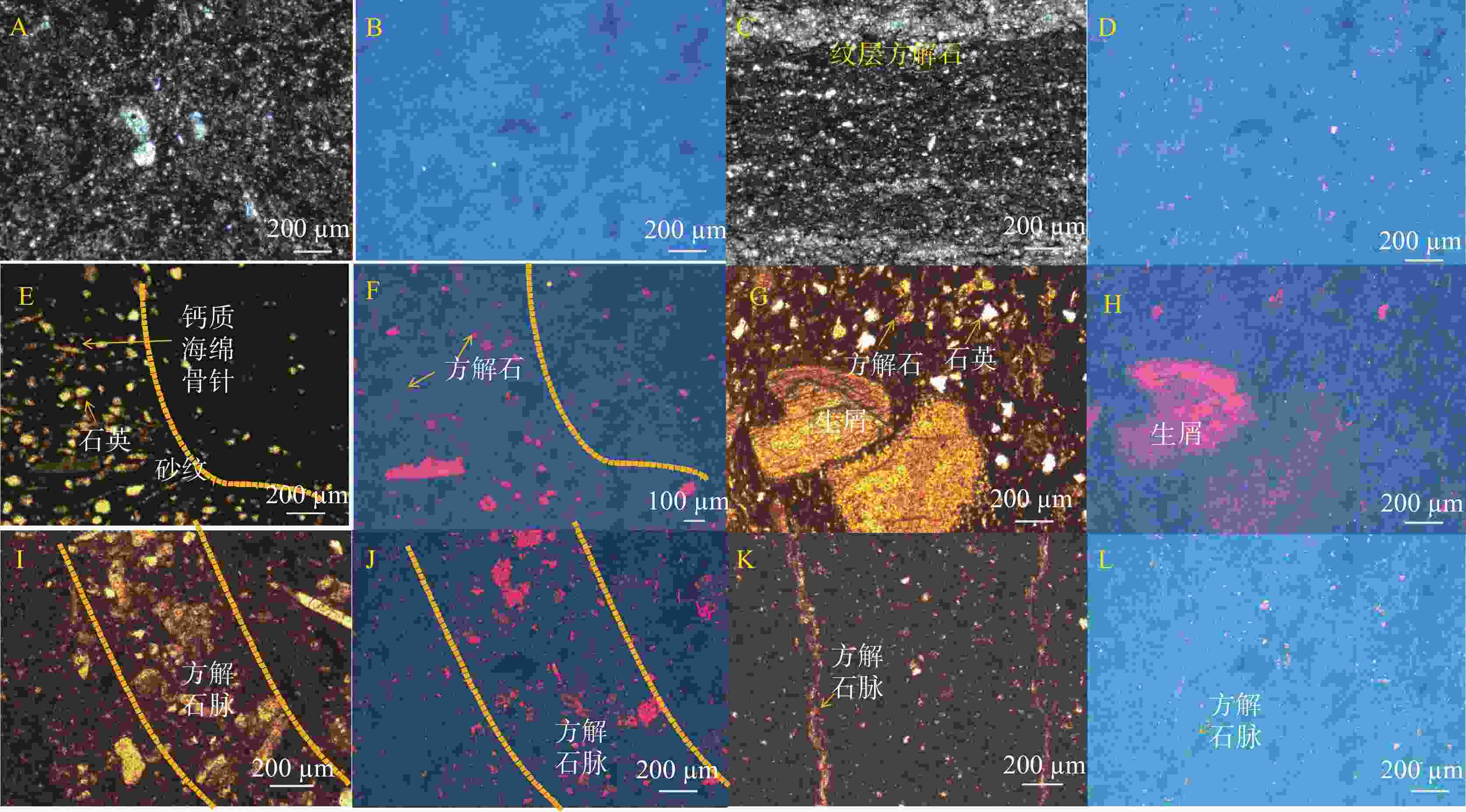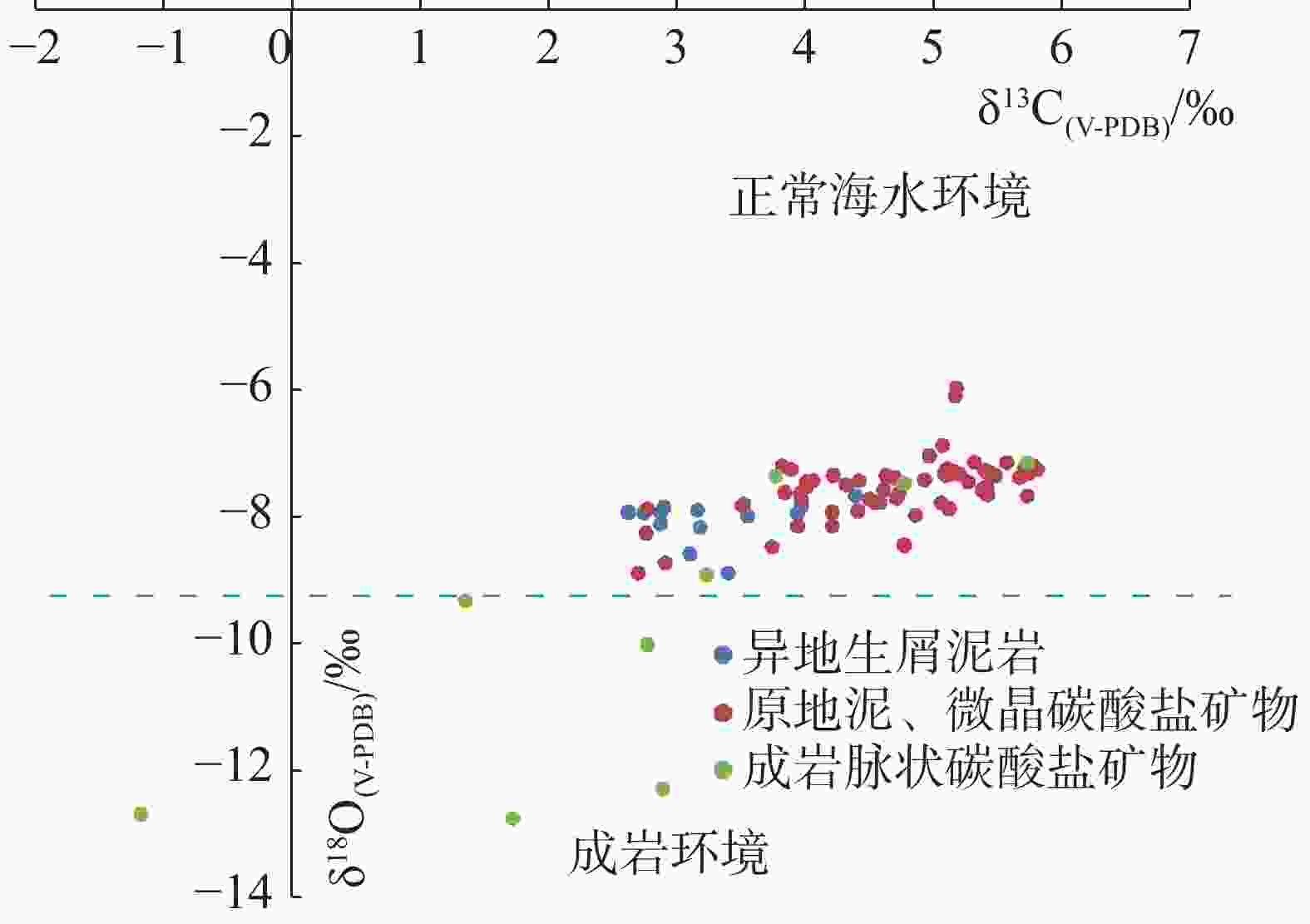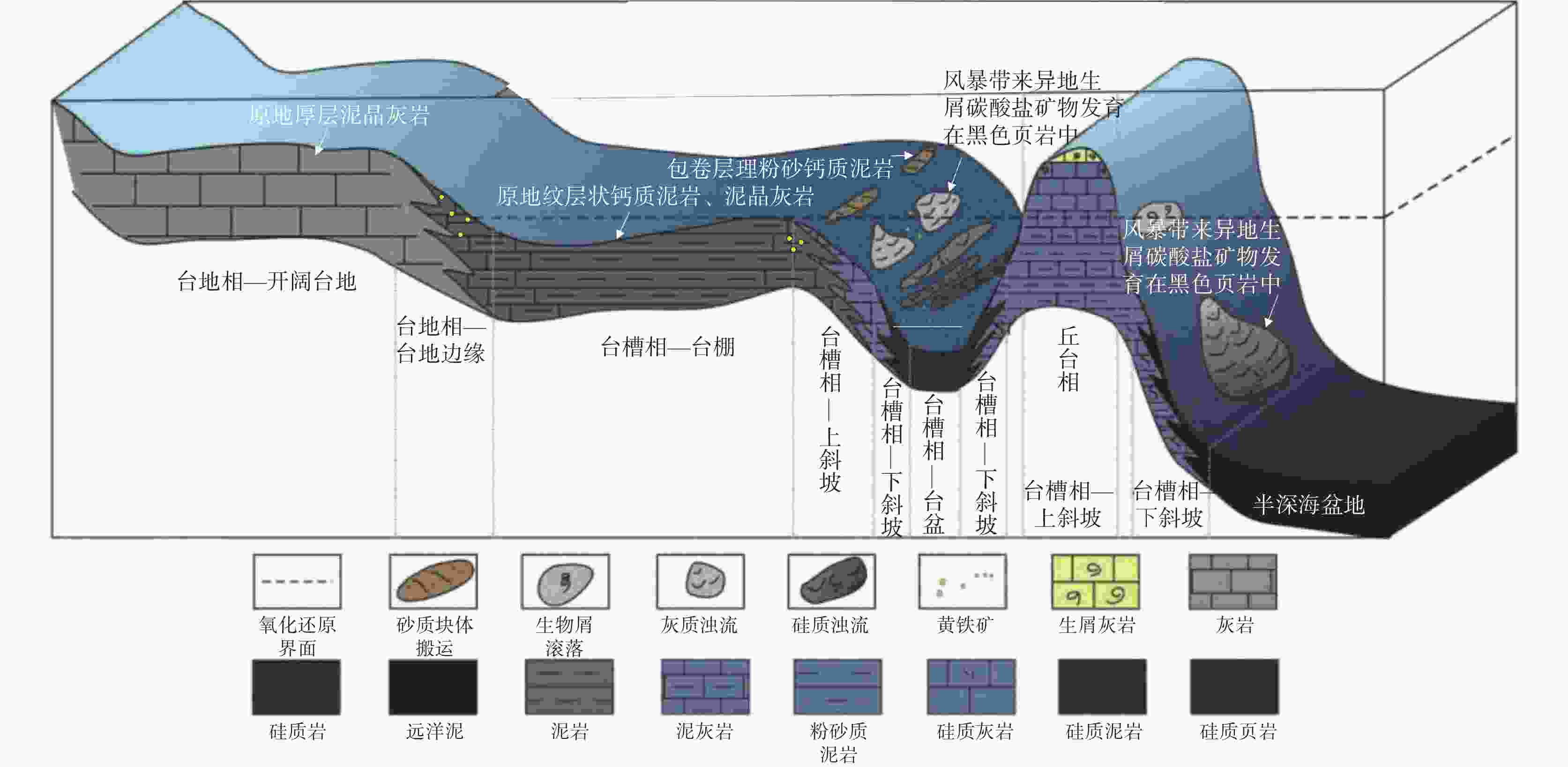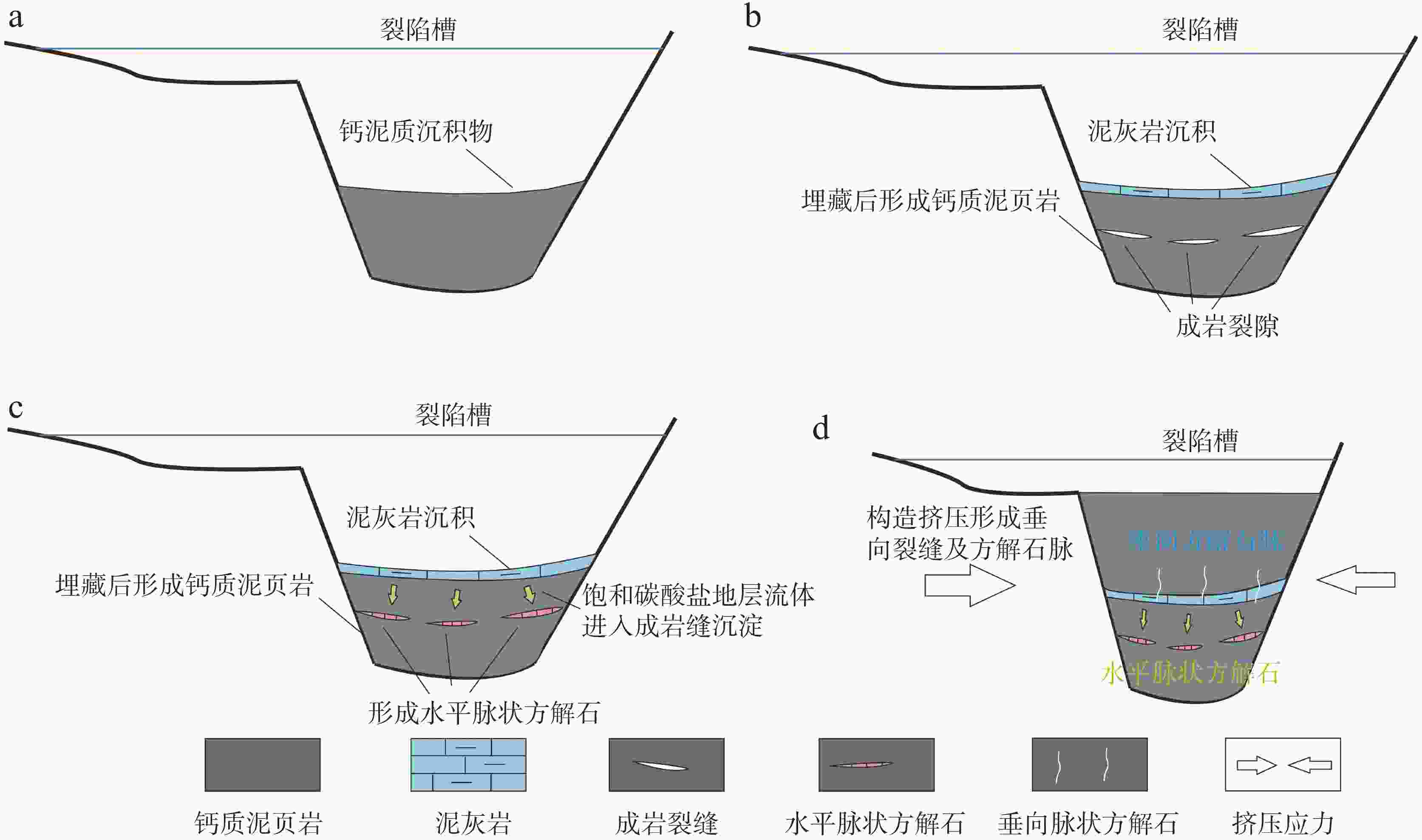Development characteristics and genetic mechanism of carbonate minerals in shale member of the lower Carboniferous Luzhai formation in the depression of central Guangxi
-
摘要: 目前桂中坳陷下石炭统鹿寨组展现出较好的页岩气勘探前景,但页岩中碳酸盐矿物含量较高,异于国内主要页岩气层的碳酸盐矿物含量,其碳酸盐矿物成因及其对页岩气产气的影响未知。文章以桂融页1井及其野外剖面为研究对象,运用X-全岩衍射、岩石薄片鉴定等手段,发现鹿寨组页岩中碳酸盐矿物以方解石为主,含量为5%~80%,平均为 30.33%,并含少量白云石(0%~9%),平均为2.1%,碳酸盐矿物主要发育在炭质页岩、钙质泥岩、粉砂质钙质泥岩、生屑炭质泥岩、泥微晶灰岩和泥质灰岩中以及顺层分布的方解石脉、穿层的构造方解石脉中。在此基础上进一步开展阴极发光、碳氧同位素分析,发现碳酸盐矿物成因主要为海水中原地正常沉积成因,其次为海水中随海浪、风暴流打碎后异地搬运成因以及成岩期重结晶成因,水平脉状方解石的形成可能为埋藏期差异压实收缩缝被地层流体充填后过饱和沉淀,而垂向脉状方解石与多期构造活动有关。Abstract:
The Carboniferous was significant for the development of "black strata" in the world. The exploration and development of shale gas in North America first began with the Carboniferous marine shale, and the Carboniferous (Mississippian) Barnett Shale has become one of the most important strata of shale gas production in the world. The distribution of Carboniferous marine shale in China is relatively limited, primarily developed in the Qian–Gui rift basin at the edge of the Yangtze plate. It is roughly distributed in depressions such as central Guangxi–Nanpanjiang in Guangxi, south Guizhou–southwest Guizhou, and central Hunan. In recent years, drilling activities in the Carboniferous depressions, such as Guirongye Well 1 and Qianziye Well 1 have yielded promising shale gas displays. In 2023, Guirongye Well 2 achieved industrial gas flow from the Carboniferous after the compression fracture was completed, indicating favorable exploration prospects. The Carboniferous strata in the Guizhou–Guangxi region are anticipated to become the next significant exploration target in China, following the shale gas of Wufeng–Longmaxi formation. However, drilling in this area revealed a rapid phase transition in the early Carboniferous, unstable distribution of shale, high levels of carbonate minerals within the shale, and the presence of common carbonate rock interlayers. On-site experiments on water invasion and gas logging suggest that shale gas production is influenced by carbonate minerals in the shale. The origins of these carbonate minerals in the shale of this region and their impact on gas production remain unclear. To this end, the Luzhai formation shale of the early Carboniferous in the depression of central Guangxi was selected to analyze the origin of carbonate minerals within the shale. This study aims to provide theoretical reference for predicting distribution of various types of carbonate minerals in the subsequent shale formation, as well as for gas content analysis and the optimization of the lower Carboniferous shale gas "sweet spot" in the depression of central Guangxi. The study area is situated in the Liucheng slope in the northern depression of central Guangxi. Field profiles and core samples from Rongye Well 1 were utilized as the research objects. Following the identification of carbonate mineral types, geochemical analyses of cathodoluminescence and carbon and oxygen isotopes were conducted. This was achieved through a comprehensive approach including X-ray whole-rock diffraction, thin section identification, and other analytical tests. Research findings indicate as follows, (1) The study found that the carbonate minerals in the Luzhai formation shale are primarily composed of calcite, with a content ranging from 5% to 80%, averaging at 30.33%. Additionally, there is a small amount of dolomite, varing from 0% to 9%, with an average of 2.1%. Carbonate minerals are mainly developed in carbonaceous shale, calcareous mudstone, silty calcareous mudstone, bioclastic carbonaceous mudstone, mud-microcrystalline limestone, and muddy limestone. They are also present in calcite veins distributed along the layers and in structural calcite veins that traverse the layers. (2) Cathodoluminescence analysis shows that massive calcareous mudstone and horizontally laminated micrite carbonate minerals are generally non-luminescent. Some carbonate minerals in silty calcareous mudstone emit weak red light, while others do not. The luminescent carbonate minerals include calcareous cements and certain calcareous bioclastics. The "floating" carbonate bioclastics found in carbonaceous shale typically emit weak red light. Lens-shaped and vein-shaped calcite exhibits weak cathode luminescence. (3) Analyses of carbon and oxygen isotopes show that the δ13C values of native carbonate minerals range from 2.70‰ to 5.81‰, with an average of 4.68‰. The δ18O‰ values range from –8.89‰ to –5.97‰, with an average of –7.54‰. For allochthonous carbonate minerals, the δ13C values range from 2.62‰ to 4.39‰, with an average of 3.30‰, and the δ18O‰ values range from –8.89‰ to –7.67‰, with an average of –8.04‰. The δ13C‰ values of diagenetic vein-shaped carbonate minerals range from –1.18‰ to 5.73‰, with an average of 2.78‰, while the δ18O‰ values range from –12.76‰ to –5.75‰, with an average of –9.77‰. Comprehensive exploration shows that the formation of carbonate minerals primarily results from normal sedimentation in seawater, followed by long-distance transport in seawater after being fragmented by waves and storm currents, and recrystallization during diagenesis. The formation of horizontal vein-shaped calcite may be attributed to supersaturated precipitation within differential compaction and contraction fractures filled by formation fluids during burial, while the vertical vein-shaped calcite is associated with multiple tectonic activities. Based on these findings, various models of carbonate mineral genesis have been established, providing theoretical reference for the optimal selection of sweet spots for shale gas in the lower Carboniferous depression of central Guangxi. -
图 1 研究区构造位置(a)与早石炭世沉积位置图(b)(据覃英伦等[10])
Figure 1. Structural location (a) and sedimentary location during early Carboniferous (b) in the study area
图 4 桂中坳陷鹿寨组一段碳酸盐矿物产出宏观特征
A.深灰色钙质页岩夹泥晶灰岩条带及透镜体,融水大良剖面 B.深灰色钙质泥岩夹泥晶灰岩,
1602.3 ~1606.4 m,桂融页1井 C.灰黑色钙质泥岩,1544 m,桂融页1井 D.灰色泥晶灰岩与深灰色泥灰岩互层,见水平纹层,1414.32 m,桂融页1井 E.深灰色粉砂质钙质泥岩,具交错层理,1539.66 m,桂融页1井 F.含生屑炭质泥岩,生屑成“漂浮状”,1603.66 m,桂融页1井 G.具透镜状方解石脉钙质泥岩,1412.1 m,桂融页1井 H.具水平脉状方解石钙质泥岩,1534.4 m,桂融页1井 I.深灰色钙质泥岩发育网裂缝,被方解石全充填,1416.9 m,桂融页1井 J.钙质泥岩中垂直层面构造方解石脉,融水大良剖面Figure 4. Petrological macroscopic characteristics of carbonate minerals in Member 1 of Luzhai Formation in the depression of central Guangxiormation in Guizhong Depression
A.Dark gray calcareous shale with micrite stripes and lenses, Rongshuidaliang profile B.Dark gray calcareous mudstone with micite, 1,602.3–1,606.4 m, Guirongye Well 1 C.Gray-black calcareous mudstone, 1,544 m, Guirongye Well 1 D.Horizontally laminated micrite alternating with calcareous mudstone, 1,414.32 m, Guirongye Well 1 E.Cross-stratified calcareous silty mudstone, 1,539.66 m, Guirongye Well 1 F.Carbonaceous mudstone containing "floating" bioclastics, 1,603.66 m, Guirongye Well 1 G.Calcareous mudstone with lens-shaped and vein-shaped calcite, 1,412.1 m, Guirongye Well 1 H.Calcareous mudstone with horizontally vein-shaped calcite, 1,534.4 m, Guirongye Well 1 I.Dark gray calcareous mudstone with developed net fractures, completely filled with calcite, 1,416.9 m, Guirongye Well 1 J.Calcite veins are constructed in vertical plane of calcareous mudstone, Rongshuidaliang profile
图 5 桂融页1井鹿寨组碳酸盐矿物发育微观特征及其阴极发光
A.钙质泥岩,碳酸盐矿物呈泥晶状大量分布于泥岩中,
1544 m B.为A阴极发光,显示不发光,1544 m C.为图4D水平纹层泥灰岩镜下照片,深色钙质泥岩与浅色泥微晶方解石呈条带状互层 D.阴极发光为不发光,1414.32 m E.为图4E具交错层理粉砂质泥岩镜下特征,左下为粉砂质泥岩纹层,由石英、黏土、方解石混积,右上主要为黏土和方解石,为钙质泥岩纹层,1539.66 m F.为E阴极发光,部分方解石具有弱红阴极发光,部分不发光,发光碳酸盐矿物为钙质胶结物和一些钙质生屑,1539.66 m G.图4F含生屑炭质泥岩镜下特征,生屑含量可达到20%,有珊瑚、海百合、钙质海绵骨针等,生屑具有泥晶—细晶结构,泥岩中含少量石英,1603.66 m H.G中生屑阴极发光中具有弱红光,1603.66 m I.为图4G具透镜状方解石钙质泥岩镜下特征,两条黄色线内为脉体,方解石呈细晶结构,1412.1 m J.I中脉体方解石具弱红色阴极发光,1412.1 m K.为图4I网裂缝镜下特征,方解石全充填,1416.9 m L.为K阴极发光,左侧裂缝发很弱光,右侧裂缝基本不发光,1416.9 mFigure 5. Microscopic characteristics and cathodoluminescence of carbonate minerals from the Luzhai Formation in Guirongye Well 1
A. Calcareous mudstone with large quantities of micrite carbonate minerals are distributed in it B. Cathodoluminescence is non-luminous, at 1,544 m C. a photomicrograph of horizontally laminated muddy limestone of Fig.4D, with dark calcareous mudstone and light micrite calcite showing stripped interlayer D. Cathodoluminescence is non-luminous, at 1,414.32 m E.The microscopic feature of the cross-stratified silty mudstone of Fig.4E; the lower left part shows silty mudstone lamination mixing with quartz, clay, and calcite, and the upper right part mainly consists of clay and calcite, showing calcareous mudstone lamination; part of the calcite emit weak and red cathodoluminescence but part of the calcite are non-luminous F. Luminescent carbonate minerals are calcareous cements and some calcareous bioclastics, at 1,539.66 m G.The microscopic feature of bioclastic carbonaceous mudstone from Fig.4F with the contents of bioclastics reaching 20%; the mudstone includes corals, sea lilies, calcareous sponges and a small amount of quartz; the bioclastics emits weak red luminescence under cathodoluminescence H.At 1,603.66 m I.The microscopic feature of lens-shaped calcite calcareous mudstone of Fig.4G; the veins are in the two yellow lines and the calcite shows fine crystal structure;the vein calcite emits weak red cathodoluminescence J.At 1,412.1 m K.The microscopic feature of the net fractures from Fig.4I; completely filled with calcite; The left fracture emits weak luminescence while the right fracture is basically non-luminous under cathodoluminescence L.At 1,416.9 m
图 8 桂中坳陷鹿寨组脉状碳酸盐矿物成因机制
a.碳酸盐矿物与黏土混合沉积 b.埋藏期差异压实形成成岩裂缝 c.成岩裂缝被地层流体充填并生长水平脉状方解石,地层流体碳酸盐过饱和 d.受构造影响,垂向脉状方解石发育
Figure 8. Genetic mechanism of vein-shaped carbonate minerals of Luzhai Formation in the depression of central Guangxi
a.Carbonate minerals mixed with clay deposits b.Diagenetic fractures are formed by differential compaction in burial period c.The diagenetic fracture is filled by the formation fluid and grows horizontal calcite;the formation fluid is supersaturated with carbonate d.Under the influence of structure, the vertical calcite veins developed
表 1 桂中坳陷鹿寨组碳酸盐矿物发育特征及成因
Table 1. Development characteristics and genesis of carbonate minerals of the Luzhai Formation in the depression of central Guangxi
发育位置 发育类型 碳酸盐矿物含量 发育形态 阴极发光 碳氧同位素 成因分析 发育规模 纯泥岩 钙质泥岩 10%~50% 泥晶状分散于泥岩中 基本不发光 δ13C为2.70‰~5.81‰,δ18O为−8.89‰~
−5.97‰海水中原地正常沉积成因 大规模发育在目的层中 炭质泥岩 <10% 泥晶状分散于泥岩中 基本不发光 / 海水中原地正常沉积成因 小规模发育在目的层中 含粒泥岩 粉砂质泥岩 10%~50% 呈胶结物存在于石英颗粒间 部分方解石具有弱红光,部分不发光,发光为钙质胶结物和一些钙质生屑 δ13C为2.62~4.39‰ ,δ18O为−8.89‰~
−7.67‰海水中随海浪打碎后异地搬运成因 小规模发育在目的层中 含生屑炭
质泥岩5%~10% 发育在生物碎屑中为泥晶—细晶结构 碳酸盐生屑具有弱红光 海水中随风暴流打碎后异地搬运成因 小规模发育在目的层中 夹层碳
酸盐岩泥晶灰岩 >80% 发育在灰岩水平纹层中,以泥微晶结构为主 基本不发光 δ13C为2.70‰~5.81‰,δ18O‰为−8.89‰~
−5.97‰海水中原地正常沉积成因 小规模发育在目的层中 泥灰岩 50%~75% 发育在灰岩水平纹层中,以泥微晶结构为主 基本不发光 海水中原地正常沉积成因 中等规模发育在目的层中 页岩中方解
石脉体顺层透镜状
方解石脉100% 呈细—中晶
结构晶粒方解石具有弱阴极发光 δ13C为 −1.18‰~5.73‰ ,δ18O为−12.76~−5.75‰ 埋藏期差异压实收缩缝被地层流体充填后过饱和沉淀 极小规模发育在目的层中 穿层构造
方解石脉100% 呈细—中晶
结构晶粒方解石具有弱阴极发光 与多期构造活动有关 小规模发育在目的层中 -
[1] 戴金星, 董大忠, 倪云燕, 洪峰, 张素荣, 张延玲, 丁麟. 中国页岩气地质和地球化学研究的若干问题[J]. 天然气地球科学, 2020, 31(6):745-760.DAI Jinxing, DONG Dazhong, NI Yunyan, HONG Feng, ZHANG Surong, ZHANG Yanling, DING Lin. Some essential geological and geochemical issues about shale gas research in China[J]. Natural Gas Geoscience, 2020, 31(6): 745-760. [2] Scott L Montgomery, Daniel M Jarvie, Kent A Bowker, Richard M Pollastro. Mississippian Barnett shale, Fort Worth basin, north-central Texas: Gas-shale play with multi-trillion cubic foot potentia[J]. AAPG Bulletin, 2005, 89(2): 155-175. doi: 10.1306/09170404042 [3] Loucks R G, Reed R M, Ambrose W A. ABSTRACT: Mineralogy and diagenetic history of the Upper Cretaceous Woodbine sandstone in the Giant East Texas Field[J]. Gcags Transactions, 2009, 59: 485. [4] Iain A, John R Underhill. Structural constraints on Lower Carboniferous shale gas exploration in the Craven Basin, NW England[J]. Petroleum Geoscience, 2020, 26(2): 303-324. [5] 杜远生, 龚一鸣, 吴诒, 冯庆来, 刘本培. 黔桂地区泥盆纪层序地层和台内裂陷槽的形成演化[J]. 沉积学报, 1997, 15(4):11-17.DU Yuansheng, GONG Yiming, WU Yi, FENG Qinglai, LIU Benpei. Devonian sequence stratigrapny and formation and evolution of intraplatform rift trough in the Guangxi and Guizhou area, China[J]. Acta Sedimentologica Sinica, 1997, 15(4): 11-17. [6] 梅冥相, 马永生, 高金汉, 孟庆芬, 易定红, 李东海. 滇黔桂盆地及其邻区晚古生代层序地层格架及相对海平面变化[J]. 现代地质, 2002, 18(4):365-373. doi: 10.3969/j.issn.1000-8527.2002.04.006MEI Mingxiang, MA Yongsheng, GAO Jinhan, MENG Qingfen, YI Dinghong, LI Donghai. Sequence-stratigraphic framework and relative sea-level changes of Late Paleozoic in the Dianqiangui basin and its adjacent areas[J]. Geoscience, 2002, 18(4): 365-373. doi: 10.3969/j.issn.1000-8527.2002.04.006 [7] 丁文龙. 页岩气构造地质[M]. 上海:华东理工大学出版社, 2017. [8] 李建忠, 李登华, 董大忠, 王社教. 中美页岩气成藏条件、分布特征差异研究与启示[J]. 中国工程科学, 2012, 14(6): 56-63. doi: 10.3969/j.issn.1009-1742.2012.06.008LI Jianzhong, LI Denghua, DONG Dazhong, WANG Shejiao. Comparison and enlightenment on formation condition and distribution characteristics of shale gas between China and U. S.[J]. China Engineering Science, 2012, 14(6): 56-63. doi: 10.3969/j.issn.1009-1742.2012.06.008 [9] 苑坤, 王超, 覃英伦, 于抒放, 陈榕, 石砥石, 包书景, 林拓, 周志. 黔南地区(黔紫页1井)发现上古生界海相页岩气[J]. 中国地质, 2017, 44(6):1253-1254.YUAN Kun, WANG Chao, QIN Yinglun, YU Shufang, CHEN Rong, SHI Dishi, BAO Shujing, LIN Tuo, ZHOU Zhi. The discovery of Carboniferous shale gas in Qianziye-1 well of Qianan (southern Guizhou) depression[J]. Geology in China, 2017, 44(6): 1253-1254. [10] 覃英伦, 张家政, 王玉芳, 康海霞, 李娟, 张子亚, 薛宗安, 张云枭. 广西桂中坳陷(桂融页1井)探获石炭系鹿寨组页岩气[J]. 中国地质, 2021, 48(2):667-668. doi: 10.12029/gc20210225QIN Yinglun, ZHANG Jiazheng, WANG Yufang, KANG Haixia, LI Juan, ZHANG Ziya, XUE Zong'an, ZHANG Yunxiao. Discovery of shale gas by Guirongye-1 well within Carboniferous Luzhai Formation in Guizhong depression, Guangxi[J]. Geology in China, 2021, 48(2): 667-668. doi: 10.12029/gc20210225 [11] 周雁, 朱东亚, 孟庆强, 张殿伟, 沃玉进. 桂中盆地页岩气地质条件及潜力分析[J]. 成都理工大学学报(自然科学版), 2014, 41(5):529-537.ZHOU Yan, ZHU Dongya, MENG Qingqiang, ZHANG Dianwei, WO Yujin. Geological conditions and exploration potential of shale gas in central Guangxi basin, China[J].Journal of Chengdu University of Technology (Science & Technology Edition), 2014, 41(5): 529-537. [12] 罗胜元, 王传尚, 彭中勤. 桂中坳陷下石炭统鹿寨组页岩气研究[J]. 华南地质与矿产, 2016, 32(2):180-190.LUO Shengyuan, WANG Chuanshang, PENG Zhongqin. Shale gas research of Luzhai Formation, Low Carboniferous in Guizhong depression[J]. Geology and Mineral Resources of South China, 2016, 32(2): 180-190. [13] 陈粤, 黄文芳, 梁裕平, 邓宾. 广西鹿寨地区鹿寨组一段黑色页岩特征及沉积环境分析[J]. 矿产与地质, 2017, 31(3):605-612. doi: 10.3969/j.issn.1001-5663.2017.03.027CHEN Yue, HUANG Wenfang, LIANG Yuping, DENG Bin. Analysis on black shale feature and depositional environment of the first member of Luzhai Formation, Luzhai area of Guangxi[J]. Mineral Resources and Geology, 2017, 31(3): 605-612. doi: 10.3969/j.issn.1001-5663.2017.03.027 [14] 胡东风, 魏志红, 刘若冰, 范志伟, 韩京. 桂中坳陷下石炭统黑色页岩发育特征及页岩气勘探潜力[J]. 天然气工业, 2018, 38(10):28-37. doi: 10.3787/j.issn.1000-0976.2018.10.004HU Dongfeng, WEI Zhihong, LIU Ruobing, FAN Zhiwei, HAN Jing. Development characteristics and shale gas exploration potential of the Lower Carboniferous black shale in the Guizhong depression[J]. Natural Gas Industry, 2018, 38(10): 28-37. doi: 10.3787/j.issn.1000-0976.2018.10.004 [15] 周雯, 姜振学, 仇恒远, 金晓春, 王瑞湖, 岑文攀, 唐相路, 李鑫, 王国臻, 曹香妮, 孙玥. 桂中坳陷下石炭统鹿寨组页岩气成藏条件和有利区预测[J]. 石油学报, 2019, 40(7):798-812. doi: 10.7623/syxb201907004ZHOU Wen, JIANG Zhenxue, QIU Hengyuan, JIN Xiaochun, WANG Ruihu, CEN Wenpan, TANG Xianglu, LI Xin, WANG Guozhen, CAO Xiangni, SUN Yue. Shale gas accumulation conditions and prediction of favorable areas for the Lower Carboniferous Luzhai Formation in Guizhong depression[J]. Acta Petrolei Sinica, 2019, 40(7): 798-812. doi: 10.7623/syxb201907004 [16] 覃英伦, 雷雨, 蒋恕, 张仁, 张鲁川, 岑文攀, 卢炳雄. 桂中坳陷北部下石炭统鹿寨组一段页岩气成藏条件与资源潜力评价[J]. 石油科学通报, 2022, 7(2):139-154.QIN Yinglun, LEI Yu, JIANG Shu, ZHANG Ren, ZHANG Luchuan, CEN Wenpan, LU Bingxiong. Shale gas accumulation conditions and resource potential evaluation of member 1 of the Lower Carboniferous Luzhai Formation in the northern Guizhong depression[J]. Petroleum Science Bulletin, 2022, 7(2): 139-154. [17] 陶金雨, 胡宗全, 申宝剑, 潘安阳, 李楚雄, 王瑞湖, 张美玲. 滇黔桂盆地桂中坳陷下石炭统台槽相页岩沉积特征与沉积模式[J]. 石油与天然气地质, 2022, 43(2):365-377. doi: 10.11743/ogg20220210TAO Jinyu, HU Zongquan, SHEN Baojian, PAN Anyang, LI Chuxiong, WANG Ruihu, ZHANG Meiling. Sedimentary characteristics and model of platform-trough shale in the Lower Carboniferous, Guizhong depression, Dianqiangui basin[J]. Oil & Gas Geology, 2022, 43(2): 365-377. doi: 10.11743/ogg20220210 [18] 淡永, 卢炳雄, 梁彬, 张庆玉, 李景瑞. 中国南方古生界碳酸盐岩发育对页岩气成藏和开发控制问题[J]. 中国岩溶, 2018, 37(3):343-350. doi: 10.11932/karst20180304DAN Yong, LU Bingxiong, LIANG Bin, ZHANG Qingyu, LI Jingrui. Effects of Paleozoic carbonate rock on shale gas accumulation and exploitation in Southern China[J]. Carsologica Sinica, 2018, 37(3): 343-350. doi: 10.11932/karst20180304 [19] 白辰阳. 济阳坳陷纹层碳酸盐岩成因及其对页岩油富集的指示意义[D]. 北京:中国地质大学(北京), 2019.BAI Chenyang. The genesis of laminar carbonates from Jiyang sub-basin and their implicate for shale oil accumulation[D]. Beijing: China University of Geosciences (Beijing), 2019. [20] 滕建彬. 东营凹陷页岩油储层中方解石的成因及证据[J]. 油气地质与采收率, 2020, 27(2):18-25.TENG Jianbin. Origin and evidence of calcite in shale oil reservoir of Dongying sag[J]. Petroleum Geology and Recovery Efficiency, 27(2): 18-25. [21] 郭苠恒, 金振奎, 赵建华, 崔学敏, 王金艺. 四川盆地龙马溪组页岩中碳酸盐矿物形成机制[J]. 科学技术与工程, 2019, 19(18):79-85 doi: 10.3969/j.issn.1671-1815.2019.18.011GUO Qiheng, JIN Zhenkui, ZHAO Jianhua, CUI Xuemin, WANG Jinyi. Origin of carbonate minerals in organic matter-rich shale of Longmaxi Formation in the Sichuan basin[J]. Science Technology and Engineering, 2019, 19(18): 79-85. doi: 10.3969/j.issn.1671-1815.2019.18.011 [22] 郭芪恒, 金振奎, 耿一凯, 赵建华, 常睿, 崔学敏, 王金艺. 四川盆地龙马溪组页岩中碳酸盐矿物特征及对储集性能的影响[J]天然气地球科学, 2019, 30(5):616-625.GUO Qiheng, JIN Zhenkui, GENG Yikai, ZHAO Jianhua, CHANG Rui, CUI Xuemin, WANG Jinyi. The characteristics of carbonate minerals in the Longmaxi Formation gas shale and its impact on the reservoir performance in the Sichuan basin[J]. Natural Gas Geoscience, 2019, 30(5): 616-625. [23] 吴国干, 姚根顺, 徐政语, 郭庆新, 陈子炓. 桂中坳陷改造期构造样式及其成因[J]. 海相油气地质, 2009, 14(1):33-40. doi: 10.3969/j.issn.1672-9854.2009.01.005WU Guogan, YAO Genshun, XU Zhengyu, GUO Qingxin, CHEN Ziliao. Structural patterns and origin of tectonic reformation in Guizhong depression[J]. Marine Origin Petroleum Geology, 2009, 14(1): 33-40. doi: 10.3969/j.issn.1672-9854.2009.01.005 [24] 白忠峰. 桂中坳陷构造特征及其与油气关系[D]. 北京:中国地质大学, 2006.BAI Zhongfeng. Structural characteristics and the relation with the petroleum and gas in Guizhong depression[D]. Beijing: China University of Geosciences, 2006. [25] 楼章华, 尚长健, 姚根顺, 陈子炓, 金爱民. 桂中坳陷及周缘海相地层油气保存条件[J]. 石油学报, 2011, 32(3):432-441. doi: 10.7623/syxb201103009LOU Zhanghua, SHANG Changjian, YAO Genshun, CHEN Ziliao, JIN Aimin. Hydrocarbon preservation conditions in marine strata of the Guizhong depression and its margin[J]. Acta Petrolei Sinica, 2011, 32(3): 432-441. doi: 10.7623/syxb201103009 [26] 黄思静. 碳酸盐矿物的阴极发光性与其Fe, Mn含量的关系[J]. 矿物岩石, 1992, 12(4):74-79.HUANG Sijing. Relationship between cathodoluminescence and concentration of iron and manganese in carbonate minerals[J]. Mineralogy and Petrology, 1992, 12(4): 74-79. [27] Flügel E. Microfacies of carbonate rocks: Analysis, interpretation and application[M]. Berlin, Germany: Springer, 2004. [28] 董红琪, 张庆玉, 梁嘉鹏, 淡永. 广西环江凹陷深部岩溶缝洞充填物碳氧同位素特征及古环境意义[J]. 中国岩溶, 2022, 41(5):838-846, 837. doi: 10.11932/karst20220512DONG Hongqi, ZHANG Qingyu, LIANG Jiapeng, DAN Yong. Carbon and oxygen isotope characteristics and paleoenvironmental significance of deep karst fracture-cave fillings in Huanjiang sag, Guangxi[J]. Carsologica Sinica, 2022, 41(5): 838-846, 837. doi: 10.11932/karst20220512 [29] 张正红, 淡永, 梁彬, 张庆玉, 李景瑞, 郝彦珍. 塔中Ⅱ区鹰山组岩溶缝洞充填物碳氧同位素特征及环境意义[J]. 中国岩溶, 2015, 34(2):159-164. doi: 10.11932/karst20150209ZHANG Zhenghong, DAN Yong, LIANG Bin, ZHANG Qingyu, LI Jingrui, HAO Yanzhen. Characteristics of oxygen and carbon isotopes of karst fissure-cave fillings in the Yingshan Formation, Tazhong Ⅱ area, Tarim basin and their implications for environment[J]. Carsologica Sinica, 2015, 34(2): 159-164. doi: 10.11932/karst20150209 [30] 黄思静. 上扬子地台区晚古生代海相碳酸盐岩的碳、锶同位素研究[J]. 地质学报, 1997, 71(1):45-53.HUANG Sijing. A sudy on carbon and strontium isotopes of Late Paleozoic carbonate rocks in the upper Yangtze platform[J]. Acta Geologica Sinica, 1997, 71(1): 45-53. -




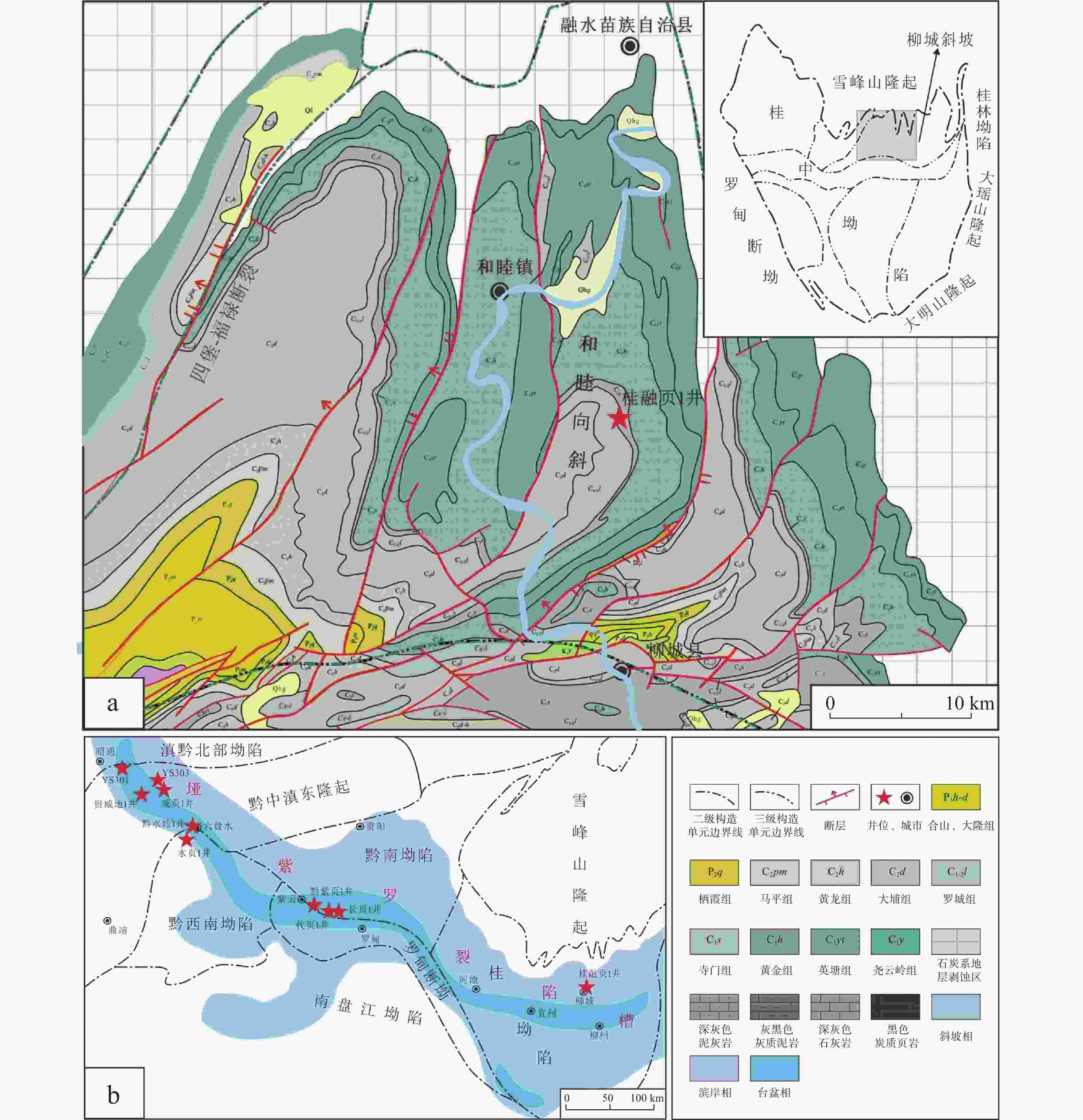
 下载:
下载:
